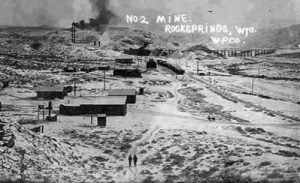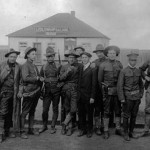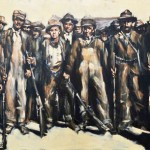coal miners
 In 1885, coal miners in Rock Springs, Wyoming Territory were trying to unionize, and were trying to strike for better working conditions, but the Union Pacific Railroad company had been besting them in their efforts for a long time. In those days, the companies often had the advantage over the workers. Working conditions suffered as a result of this disadvantage. Unions and companies were constantly at odds, for obvious reasons. I suppose that in any business, there are good and bad people. Sometimes, when people come into power in an organization, corruption follows. The companies of that time didn’t want to do what was necessary to make working in the mines safe, and as most people know, underground mining can be a very dangerous occupation. The chance of cave ins or explosions exists in even the safest mines, as well as having poisonous gasses leaking into the limited air supply, bringing death to the miners.
In 1885, coal miners in Rock Springs, Wyoming Territory were trying to unionize, and were trying to strike for better working conditions, but the Union Pacific Railroad company had been besting them in their efforts for a long time. In those days, the companies often had the advantage over the workers. Working conditions suffered as a result of this disadvantage. Unions and companies were constantly at odds, for obvious reasons. I suppose that in any business, there are good and bad people. Sometimes, when people come into power in an organization, corruption follows. The companies of that time didn’t want to do what was necessary to make working in the mines safe, and as most people know, underground mining can be a very dangerous occupation. The chance of cave ins or explosions exists in even the safest mines, as well as having poisonous gasses leaking into the limited air supply, bringing death to the miners.
The situation took a deadly turn on September 2, 1885, when 150 white miners brutally attacked their Chinese coworkers, killing 28 and wounding 11 others, while driving several others out of town. The Chinese weren’t really the problem, except that they were hard workers, and so the company had initially decided to bring them in as strikebreakers. The Chinese workers showed very little interest in the miners’ union, and I’m sure this  made the rest of the miners very angry. The miners became outraged by a company decision to allow the Chinese miners to work in the richest coal mines, and before long, the situation turned into a mob of white miners deciding to strike back by attacking the small area of Rock Springs known as Chinatown.
made the rest of the miners very angry. The miners became outraged by a company decision to allow the Chinese miners to work in the richest coal mines, and before long, the situation turned into a mob of white miners deciding to strike back by attacking the small area of Rock Springs known as Chinatown.
When the Chinese saw the white miners coming, most of them abandoned their homes and business, running for the hills. Those who failed to get out in time were brutally beaten, and 28 of them, beaten to death. One week later, on September 9, United States troops escorted the surviving Chinese back into the town where many of them returned to work. I guess they were either very loyal, desperate for the money, or had no other real choices, because I can’t imagine going back to work in that situation. Eventually the Union Pacific fired 45 of the white miners for their roles in the massacre, but no effective legal action was ever taken against any of the participants…no repercussion for the brutal murder of 28 Chinese men.
I wound never agree with murder, but it was also wrong to use the Chinese in this way. By bringing them in as strikebreakers, the Union Pacific Railroad effectively caused the anti-Chinese sentiment that was shared by  many, and began to come to the West in the mid-nineteenth century, fleeing famine and political upheaval in their own country. The Chinese were many Americans at that time. The Chinese had been victims of prejudice and violence ever since they first widely blamed for all sorts of social ills. They were also singled-out for attack by some national politicians who popularized strident slogans like “The Chinese Must Go” and helped pass an 1882 law that closed the United States to any further Chinese immigration. The Rock Springs massacre was just another symptom in this climate of racial hatred, violent attacks against the Chinese in the West became all too common. But, the Rock Springs massacre was the worst, both for its size and savage brutality.
many, and began to come to the West in the mid-nineteenth century, fleeing famine and political upheaval in their own country. The Chinese were many Americans at that time. The Chinese had been victims of prejudice and violence ever since they first widely blamed for all sorts of social ills. They were also singled-out for attack by some national politicians who popularized strident slogans like “The Chinese Must Go” and helped pass an 1882 law that closed the United States to any further Chinese immigration. The Rock Springs massacre was just another symptom in this climate of racial hatred, violent attacks against the Chinese in the West became all too common. But, the Rock Springs massacre was the worst, both for its size and savage brutality.
 When strikes occur, emotions can get out of control. Sometimes, tensions get so high that they hit the breaking point, and people die. The year was 1914. The date was April 20th. The place was Ludlow, Colorado, and things were about to get out of control. The strike began the previous September, when about 11,000 miners in southern Colorado went on strike against the powerful Colorado Fuel and Iron Corporation. They were protesting low pay, dangerous working conditions, and the company’s autocratic dominance over the workers’ lives. The company was owned by the Rockefeller family and Standard Oil. They responded to the strike by immediately evicting the miners and their families from company-owned housing, which were basically shacks. The United Mine Workers stepped in to help. The miners moved with their families to canvas tent colonies scattered around the nearby hills and the strike continued.
When strikes occur, emotions can get out of control. Sometimes, tensions get so high that they hit the breaking point, and people die. The year was 1914. The date was April 20th. The place was Ludlow, Colorado, and things were about to get out of control. The strike began the previous September, when about 11,000 miners in southern Colorado went on strike against the powerful Colorado Fuel and Iron Corporation. They were protesting low pay, dangerous working conditions, and the company’s autocratic dominance over the workers’ lives. The company was owned by the Rockefeller family and Standard Oil. They responded to the strike by immediately evicting the miners and their families from company-owned housing, which were basically shacks. The United Mine Workers stepped in to help. The miners moved with their families to canvas tent colonies scattered around the nearby hills and the strike continued.
The company had depended on the evictions to end the strike, but when that failed, they hired private detectives to attack the tent colonies with rifles and Gatling guns. The miners fought back and several were killed. The company began to realize that the strikers were determined so Colorado Fuel and Iron Corporation contacted the governor of Colorado, who authorized the use of the National Guard, provided they agree to pay their wages. The strikers mistakenly thought that the governor has sent the National Guard to protect them, but that couldn’t have been further from the truth. The National Guard was under orders to stop the strike…no matter what the cost might be. The National Guard attacked the strikers on April 20, 1914. Two companies of guardsmen attacked the largest tent colony of strikers near the town of Ludlow, home to about 1,000 men, women, and children. The attack began in the morning with a barrage of bullets fired into the tents. The miners shot back with pistols and rifles.
A strike leader was killed while trying to negotiate a truce, and the strikers, fearing that the attacks might intensify. They tried to placed the women and children in pits they had dug beneath the tents. At sunset, the  guardsman moved down from the hills and set the tent colony on fire with torches, shooting at the families as they fled into the hills. It wasn’t until the next morning that they discovered the true carnage of their attack. A telephone linesman discovered a pit under one of the tents filled with the burned remains of 11 children and 2 women. The Ludlow Massacre outraged many Americans, nevertheless, the tragedy did little to help the Colorado miners and their families. Federal troops were sent to assure the end of the strike, and the strike failed to achieve any significant improvement in their wages and working conditions. Sixty-six men, women, and children died during the strike, but not a single militiaman or private detective was charged with any crime. Sometimes, the worst injustice comes from the very people who are supposed to protect us.
guardsman moved down from the hills and set the tent colony on fire with torches, shooting at the families as they fled into the hills. It wasn’t until the next morning that they discovered the true carnage of their attack. A telephone linesman discovered a pit under one of the tents filled with the burned remains of 11 children and 2 women. The Ludlow Massacre outraged many Americans, nevertheless, the tragedy did little to help the Colorado miners and their families. Federal troops were sent to assure the end of the strike, and the strike failed to achieve any significant improvement in their wages and working conditions. Sixty-six men, women, and children died during the strike, but not a single militiaman or private detective was charged with any crime. Sometimes, the worst injustice comes from the very people who are supposed to protect us.

